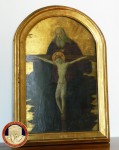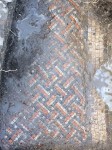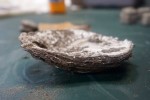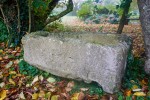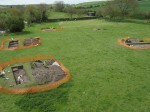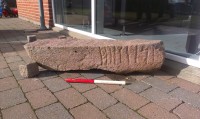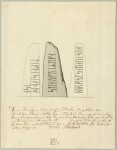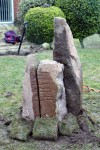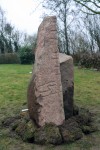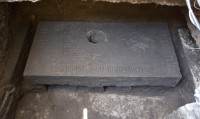 Engineers with the Trust of the Historic Center of Mexico City were installing one of eight new lampposts to illuminate the facade of the Metropolitan Cathedral when, digging deeper than expected, they came across the tombstone of one of the first Catholic priests in Mexico. They notified the Program of Urban Archaeology (PAU) of the Templo Mayor Museum and their archaeologists excavated the find.
Engineers with the Trust of the Historic Center of Mexico City were installing one of eight new lampposts to illuminate the facade of the Metropolitan Cathedral when, digging deeper than expected, they came across the tombstone of one of the first Catholic priests in Mexico. They notified the Program of Urban Archaeology (PAU) of the Templo Mayor Museum and their archaeologists excavated the find.
The horizontal slab was found in front of the central door of the cathedral about four feet beneath the current floor. It’s a greenish volcanic stone called chiluca and is engraved around the borders with an epitaph in ancient Castilian recording the name of the priest: Miguel de Palomares. It’s followed by an inscription in Greek which has yet to be translated but could be de Palomares’ birth and death dates. Carved on the middle of the stone is a shield with three fleurs de lys, possibly a reference to the Dominican order whose emblems include fleurs de lys, although they’re usually added to the end of crosses or squeezed together to form a cross.
It’s not known whether Miguel de Palomares was a member of the Dominican order. He was a prominent figure in Mexico City in the first half of the 16th century, a member of the first church council convened in the cathedral. He died in 1542 and was buried near an altar inside the first church which was later demolished to make room for the current cathedral. Archaeologists have not yet lifted the slab and so don’t know whether his remains are still buried beneath it.
 Today it’s the largest cathedral in the Americas, but the first church on the site was a more modest affair. It was built in 1524, three years after the Spanish conquest of Tenochtitlan. Hernán Cortés himself laid the first stone at the crossroads of the four cardinal points at the southern boundary of the Sacred Precinct. The stones used to build the church were taken from the destroyed Templo Mayor.
Today it’s the largest cathedral in the Americas, but the first church on the site was a more modest affair. It was built in 1524, three years after the Spanish conquest of Tenochtitlan. Hernán Cortés himself laid the first stone at the crossroads of the four cardinal points at the southern boundary of the Sacred Precinct. The stones used to build the church were taken from the destroyed Templo Mayor.
The first bishop of Mexico, Franciscan Juan de Zumárraga, was appointed in 1530. The Archdiocese of Mexico was established in 1546 with Zumárraga as archbishop. The church was now designated a cathedral, but it was deemed too small for the seat of an increasingly important archbishopric. The funding for a new cathedral was sorted out in 1552. Work on the foundations began in 1562 and construction would continue for centuries. The original church was demolished in 1628 when enough of the new cathedral was built to make it usable. It was finally completed in 1813.
The discovery of the slab sheds light on how Cortés didn’t just destroy the Aztec sacred architecture and reuse the materials, but rather integrated structures into the church.
The nearly 2-metre-long slab was sunk into the same level of the stucco floor of what appears to be an Aztec temple. The cathedral was simply built over the temple and apparently used the same floor. The Spaniards apparently gave the floor only a thin coat of lime whitewash before using it for their church.
“The Spaniards, Hernán Cortes and his followers, made use of the pre-Hispanic structures, the temples, the foundations, the floors,” said Raúl Barrera, an archaeologist for the government’s National Institute of Anthropology and History. “They even used the walls, the floors. They couldn’t destroy everything all at once.” […]
Archaeologists have long known the Spaniards often appeared to prefer to build their churches atop Aztec temples, but it was thought that was for symbolic purposes, to signal the displacement of old Aztec gods by the Christian church. But it may also have been a practical decision, as the pre-Hispanic temples had good foundations, walls and floors that the Spaniards could use, saving them the trouble of building new ones.
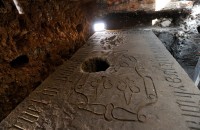 Construction of the new cathedral damaged the tombstone. It is perforated with a large hole that likely had a post or cross embedded into it. Chiluca is a delicate stone, and since this one has already been damaged, archaeologists are being very cautious before attempting to raise the slab and transport it to the Templo Mayor Museum.
Construction of the new cathedral damaged the tombstone. It is perforated with a large hole that likely had a post or cross embedded into it. Chiluca is a delicate stone, and since this one has already been damaged, archaeologists are being very cautious before attempting to raise the slab and transport it to the Templo Mayor Museum.
Other architectural elements from the first church have been unearthed alongside the slab. There are stones next to the slab that archaeologists believe were part of the long-defunct altar. They’ve also found the remains of a perimeter wall from the original church.
It’s very rare for archaeologists to have a chance to study known historical figures, and as Miguel de Palomares was associated with an important transitional period after the conquest, PAU experts hope they’ll find his remains which would give us new information about Catholic burial practices in the first half of the 16th century and the diet of Spanish colonists.



